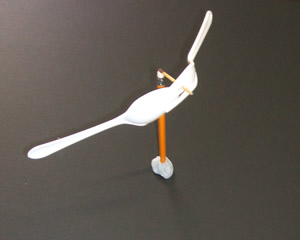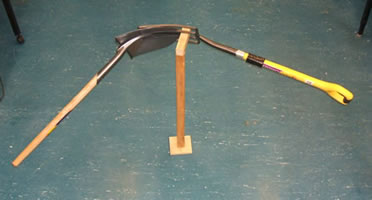Abstract
Surprising stable equilibrium point for a fork and spoon appearing to be suspended unnaturally by a match.


Portable
Yes
Principles Illustrated
This fun, homemade demonstration illustrates centre of mass and also stable and unstable equilibrium.
NCEA & Science Curriculum
SCI 1.1, PHYS 2.4
Instructions

The Plastic Version:
The plastic fork and spoon version is very inexpensive. Students keep this version and take it home, helping to involve their families in their science education.
This version needs suitable plastic forks and spoons, pencils, and Blu-Tack. Assemble as is the drawing below with a small dab of Blu-Tack in the teeth of the fork to keep the fork and spoon together. Try more than one kind of plastic fork and spoon. Somewhat larger ones are better and they need to be roughly the same mass. We have found that some Basics brand forks and spoons seem to work pretty well but others do also.
Other Versions:
We have a giant version of this made with a pitchfork and shovel that seems to amuse people. Click here to see photos.
Click here for photos of a commercial device that works on a similar principle.
Click here version with metal fork and spoon will require bending the spoon somewhat.
If you have trouble getting this to work try adjusting the fork and spoon a bit.
Safety
Safety note: be careful of feet — these are fairly heavy garden tools. You don’t want them landing on toes! And the device topples easily. The small version has small parts.
Individual teachers are responsible for safety in their own classes. Even familiar demonstrations should be practised and safety-checked by individual teachers before they are used in a classroom.
Related Resources
Teaching Resources
Would you like to contribute lesson suggestions? Contact us.
References
PIRA 1J20.20
Credits
This teaching resource was developed with support from
The MacDiarmid Institute
Faculty of Science, Victoria University of Wellington
School of Chemical and Physical Sciences, Victoria University of Wellington